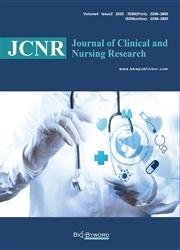Preserving Spontaneous Breathing Without Intubation and Endotracheal Intubation with One Lung Ventilation in Single-hole Thoracoscopic Bulla Suture
引用次数: 0
Abstract
Objective: To explore the situation of patients and the compare the effect between two methods, which are preserving spontaneous breathing without intubation and endotracheal intubation with one lung ventilation in the single-hole thoracoscopic bulla suture. Method: 42 patients who received single-hole thoracoscopic pulmonary bullae suture in our hospital from January 2020 to December 2021 were selected as the study subjects, including 19 patients who underwent endotracheal intubation and one lung ventilation as the control group and 23 patients who underwent single-hole thoracoscopic pulmonary bullae suture without intubation as the study group. The relevant indexes, postoperative general conditions, complications and pneumothorax recurrence of the two groups were analyzed and observed. Results: In the control group, the scores of anesthesia time (points), resuscitation time (points), surgical visual field score (points), surgical time (points), and surgical bleeding volume (points) were 20.8 ± 4.6, 19.9 ± 7.9, 1.7 ± 0.5, 44.9 ± 7.9, and 11.4 ± 2.4 respectively. In the study group, the scores of anesthesia time (points), resuscitation time (points), surgical visual field score (points), surgical time (points), and scores of surgical bleeding (points) were 17.9 ± 4.3, 15.4 ± 3.4, 1.9 ± 0.4, 48.4 ± 7.1, 10.9 ± 2.2, respectively. There was no statistical difference in surgical visual field score, surgical time and surgical bleeding whereas there was a statistical difference between anesthesia time and resuscitation time. In the control group after operation, VAS score at 6 hours after operation, SaO2 (%) after operation, PaCO2 (mmHg) after operation, drainage volume (ML) after operation, feeding time (H) after operation, retention time of thoracic tube after operation (H), WBC (109) on the first day after operation, hospitalization time (d), and total hospitalization cost (RMB 1000) were 2.1 ± 0.7, 98.2 ± 1.4, 42.4 ± 4.9, 139.1 ± 23.1, 6.9 ± 1.6, 37.1 ± 5.4, 7.9 ± 2.1, 6.6 ± 1.3, and 2.6 ± 0.3 respectively. As for the study group, the VAS score at 6 hours after operation, SaO2 (%) after operation, PaCO2 (mmHg) after operation, drainage volume (ML) after operation, feeding time (H) after operation, retention time of thoracic tube after operation (H), WBC (109) on the first day after operation, hospitalization time (d), and total hospitalization cost (RMB 1000) were 1.9 ± 0.4, 97.9 ± 1.2, 42.8 ± 5.1, 151.8 ± 21.9, 4.3 ± 1.4, 15.3 ± 2.6, 5.2 ± 2.3, 4.2 ± 1.2, and 1.8 ± 0.4 respectively. Among them, there were no significant differences in visual analog scale (VAS) score at 6 hours after operation, SaO2 after operation and PaCO2 after operation between the two groups, but there were significant differences in other factors. The complication rate of the control group was 36.84%, which was significantly higher than that of the study group (4.35%), with statistical difference. The recurrence rate of the control group was 21.05%, which was not significantly different from that of the study group (4.35%). Conclusion: The single-hole thoracoscopic bullae suture without intubation can reduce the anesthesia time and resuscitation time of patients, reduce the hospitalization cost of patients, reduce the treatment burden, shorten the first feeding time, and reduce the complication rate of patients. Therefore, it is worthy of clinical promotion.单孔胸腔镜下保自主呼吸不插管与单肺通气气管插管大疱缝合术
目的:探讨单孔胸腔镜大球缝合中保留自主呼吸不插管与气管插管单肺通气两种方法的疗效比较。方法:选取2020年1月至2021年12月在我院行单孔胸腔镜肺大泡缝合术的患者42例作为研究对象,其中气管插管加一次肺通气的患者19例为对照组,不插管行单孔胸腔镜肺大泡缝合术的患者23例为研究组。分析观察两组患者的相关指标、术后一般情况、并发症及气胸复发情况。结果:对照组麻醉时间(分)、复苏时间(分)、手术视野评分(分)、手术时间(分)、手术出血量(分)分别为20.8±4.6、19.9±7.9、1.7±0.5、44.9±7.9、11.4±2.4。研究组麻醉时间(分)、复苏时间(分)、手术视野评分(分)、手术时间(分)、手术出血评分(分)分别为17.9±4.3、15.4±3.4、1.9±0.4、48.4±7.1、10.9±2.2。手术视野评分、手术时间、手术出血量差异无统计学意义,麻醉时间与复苏时间差异有统计学意义。对照组术后,脉管的分数在手术后6小时,SaO2(%)操作后,PaCO2操作后(毫米汞柱),排水体积(ML)操作后,喂食的时候(H)操作后,保留时间的胸管后操作(H),白细胞(109)术后第一天,住院时间(d),和住院总成本(1000元)2.1±0.7,98.2±1.4,42.4±4.9,139.1±23.1,6.9±1.6,37.1±5.4,7.9±2.1,6.6±1.3,2.6±0.3。至于学习小组,脉管分数在手术后6小时,SaO2(%)操作后,PaCO2操作后(毫米汞柱),排水体积(ML)操作后,喂食的时候(H)操作后,保留时间的胸管后操作(H),白细胞(109)术后第一天,住院时间(d),和住院总成本(1000元)1.9±0.4,97.9±1.2,42.8±5.1,151.8±21.9,4.3±1.4,15.3±2.6,5.2±2.3,4.2±1.2,1.8±0.4。其中,两组术后6 h视觉模拟评分(VAS)、术后SaO2、PaCO2比较差异无统计学意义,但其他因素比较差异有统计学意义。对照组并发症发生率为36.84%,显著高于研究组(4.35%),差异有统计学意义。对照组复发率为21.05%,与研究组复发率(4.35%)差异无统计学意义。结论:单孔胸腔镜大泡缝合无需插管,可减少患者麻醉时间和复苏时间,降低患者住院费用,减轻治疗负担,缩短首次喂养时间,减少患者并发症发生率。因此,值得临床推广。
本文章由计算机程序翻译,如有差异,请以英文原文为准。
求助全文
约1分钟内获得全文
求助全文

 求助内容:
求助内容: 应助结果提醒方式:
应助结果提醒方式:


